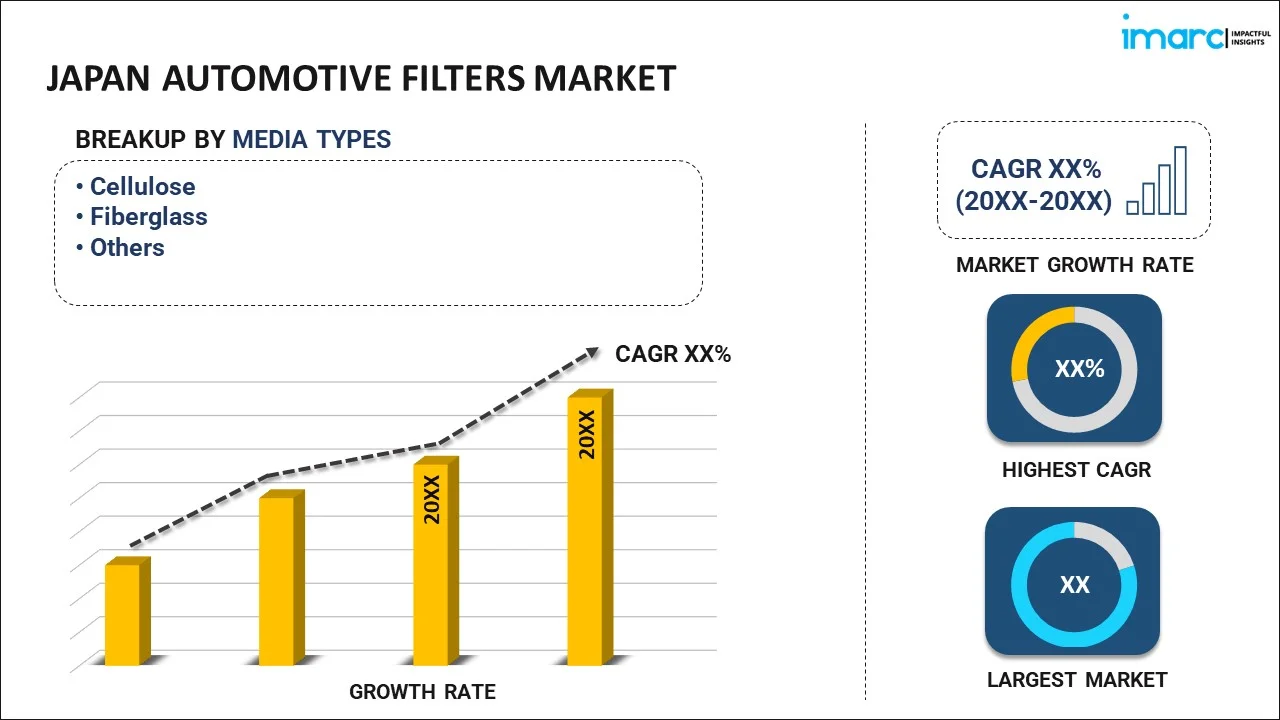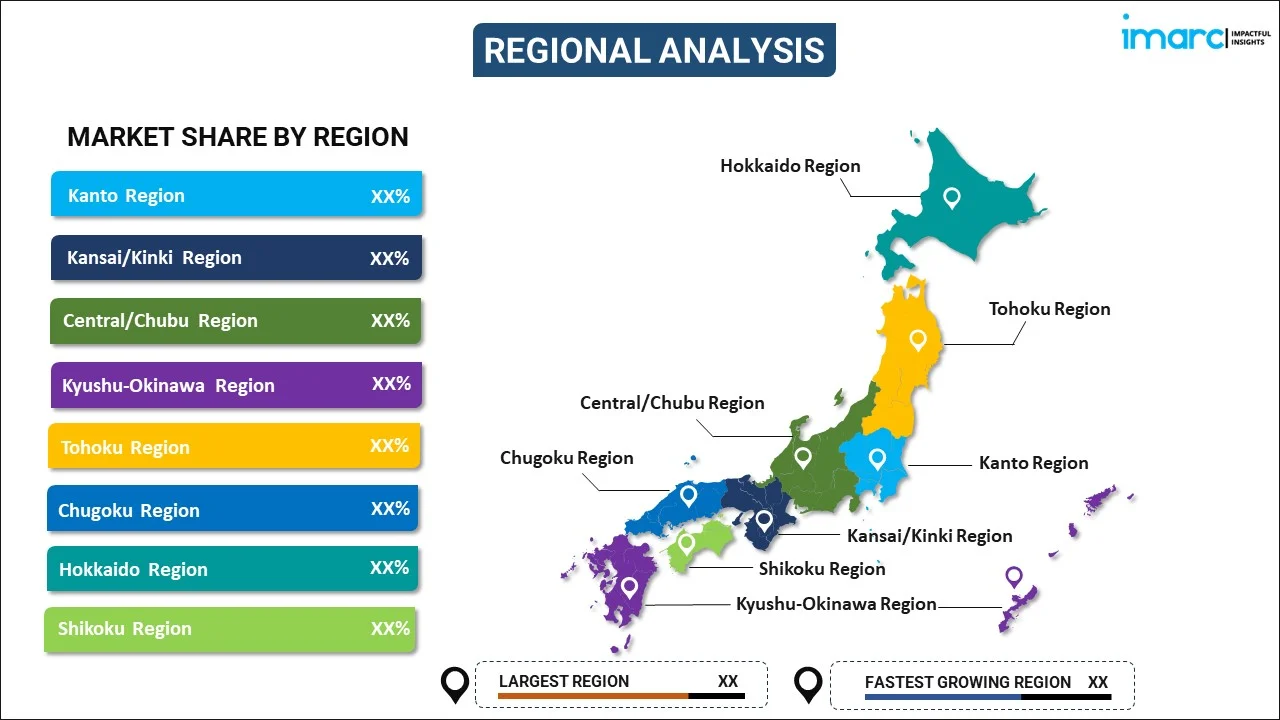
Japan Automotive Filters Market Report by Media Type (Cellulose, Fiberglass, and Others), Filter Type (Air Filters, Fuel Filters, Hydraulic Filters, Oil Filters, Steering Filters, Coolant Filters, and Others), Distribution Channel (OEM, Aftermarket), Vehicle Type (Commercial Vehicles, Passenger Vehicles, and Others), and Region 2025-2033
Market Overview:
Japan automotive filters market size reached USD 1,419.4 Million in 2024. Looking forward, IMARC Group expects the market to reach USD 1,959.5 Million by 2033, exhibiting a growth rate (CAGR) of 3.6% during 2025-2033. The implementation of stringent standards by government bodies regarding greenhouse gas (GHG) emissions and the fuel economy of vehicles is primarily driving the market growth.
|
Report Attribute
|
Key Statistics
|
|---|---|
|
Base Year
|
2024 |
|
Forecast Years
|
2025-2033
|
|
Historical Years
|
2019-2024
|
| Market Size in 2024 | USD 1,419.4 Million |
| Market Forecast in 2033 | USD 1,959.5 Million |
| Market Growth Rate (2025-2033) | 3.6% |
Automotive filters serve the purpose of safeguarding the vehicle by blocking the entry of detrimental pollutants, impurities, and contaminants. They also have the capability to trap allergens such as pollen, fine dust particles, and unpleasant odors that may infiltrate the vehicle through the heating, ventilation, and air conditioning (HVAC) system. This not only contributes to the preservation of a clean and healthy interior environment but also plays a crucial role in preventing rapid windscreen condensation, which can impair visibility. Additionally, automotive filters are recognized for their capacity to enhance engine performance and reduce fuel consumption. As a result, they are garnering global attention as a means to mitigate the environmental impact of vehicles, aligning with the broader sustainability objectives in the automotive industry.
Japan Automotive Filters Market Trends:
The Japan automotive filters market is experiencing substantial growth, primarily driven by the increasingly stringent vehicular emission control regulations enforced by government authorities worldwide. This heightened regulation is a response to the escalating levels of greenhouse gas (GHG) emissions and the growing air pollution concerns, particularly in urban areas. As a result, the demand for automotive filters is on the rise, driven by the need to absorb air pollutants and deliver cleaner air. The surge in automobile sales contributes significantly to the adoption of filters, as the automotive industry seeks to comply with emissions standards. Moreover, the deteriorating air quality in urban regions has led to a higher incidence of respiratory disorders, further emphasizing the importance of effective filtration systems. Several other factors contribute to the market's growth, including continuous technological advancements in filter technology, an increase in disposable income among the populace, a rising demand for luxury vehicles, and extensive research and development (R&D) initiatives by key industry players. These factors will collectively underscore the significance of the Japan automotive filters market in addressing environmental concerns and improving air quality in the country over the forecasted period.
Japan Automotive Filters Market Segmentation:
IMARC Group provides an analysis of the key trends in each segment of the market, along with forecasts at the country level for 2025-2033. Our report has categorized the market based on media type, filter type, distribution channel, and vehicle type.
Media Type Insights:

- Cellulose
- Fiberglass
- Others
The report has provided a detailed breakup and analysis of the market based on the media type. This includes cellulose, fiberglass, and others.
Filter Type Insights:
- Air Filters
- Fuel Filters
- Hydraulic Filters
- Oil Filters
- Steering Filters
- Coolant Filters
- Others
A detailed breakup and analysis of the market based on the filter type have also been provided in the report. This includes air filters, fuel filters, hydraulic filters, oil filters, steering filters, coolant filters, and others.
Distribution Channel Insights:
- OEM
- Aftermarket
The report has provided a detailed breakup and analysis of the market based on the distribution channel. This includes OEM and aftermarket.
Vehicle Type Insights:
- Commercial Vehicles
- Passenger Vehicles
- Others
A detailed breakup and analysis of the market based on the vehicle type have also been provided in the report. This includes commercial vehicles, passenger vehicles, and others.
Regional Insights:

- Kanto Region
- Kansai/Kinki Region
- Central/ Chubu Region
- Kyushu-Okinawa Region
- Tohoku Region
- Chugoku Region
- Hokkaido Region
- Shikoku Region
The report has also provided a comprehensive analysis of all the major regional markets, which include Kanto Region, Kansai/Kinki Region, Central/ Chubu Region, Kyushu-Okinawa Region, Tohoku Region, Chugoku Region, Hokkaido Region, and Shikoku Region.
Competitive Landscape:
The market research report has also provided a comprehensive analysis of the competitive landscape. Competitive analysis such as market structure, key player positioning, top winning strategies, competitive dashboard, and company evaluation quadrant has been covered in the report. Also, detailed profiles of all major companies have been provided.
Japan Automotive Filters Market Report Coverage:
| Report Features | Details |
|---|---|
| Base Year of the Analysis | 2024 |
| Historical Period | 2019-2024 |
| Forecast Period | 2025-2033 |
| Units | Million USD |
| Scope of the Report | Exploration of Historical Trends and Market Outlook, Industry Catalysts and Challenges, Segment-Wise Historical and Future Market Assessment:
|
| Media Types Covered | Cellulose, Fiberglass, Others |
| Filter Types Covered | Air Filters, Fuel Filters, Hydraulic Filters, Oil Filters, Steering Filters, Coolant Filters, Others |
| Distribution Channels Covered | OEM, Aftermarket |
| Vehicle Types Covered | Commercial Vehicles, Passenger Vehicles, Others |
| Regions Covered | Kanto Region, Kansai/Kinki Region, Central/ Chubu Region, Kyushu-Okinawa Region, Tohoku Region, Chugoku Region, Hokkaido Region, Shikoku Region |
| Customization Scope | 10% Free Customization |
| Post-Sale Analyst Support | 10-12 Weeks |
| Delivery Format | PDF and Excel through Email (We can also provide the editable version of the report in PPT/Word format on special request) |
Key Questions Answered in This Report:
- How has the Japan automotive filters market performed so far and how will it perform in the coming years?
- What has been the impact of COVID-19 on the Japan automotive filters market?
- What is the breakup of the Japan automotive filters market on the basis of media type?
- What is the breakup of the Japan automotive filters market on the basis of filter type?
- What is the breakup of the Japan automotive filters market on the basis of distribution channel?
- What is the breakup of the Japan automotive filters market on the basis of vehicle type?
- What are the various stages in the value chain of the Japan automotive filters market?
- What are the key driving factors and challenges in the Japan automotive Filters?
- What is the structure of the Japan automotive filters market and who are the key players?
- What is the degree of competition in the Japan automotive filters market?
Key Benefits for Stakeholders:
- IMARC’s industry report offers a comprehensive quantitative analysis of various market segments, historical and current market trends, market forecasts, and dynamics of the Japan automotive filters market from 2019-2033.
- The research report provides the latest information on the market drivers, challenges, and opportunities in the Japan automotive filters market.
- Porter's five forces analysis assist stakeholders in assessing the impact of new entrants, competitive rivalry, supplier power, buyer power, and the threat of substitution. It helps stakeholders to analyze the level of competition within the Japan automotive filters industry and its attractiveness.
- Competitive landscape allows stakeholders to understand their competitive environment and provides an insight into the current positions of key players in the market.
Need more help?
- Speak to our experienced analysts for insights on the current market scenarios.
- Include additional segments and countries to customize the report as per your requirement.
- Gain an unparalleled competitive advantage in your domain by understanding how to utilize the report and positively impacting your operations and revenue.
- For further assistance, please connect with our analysts.
 Inquire Before Buying
Inquire Before Buying
 Speak to an Analyst
Speak to an Analyst
 Request Brochure
Request Brochure
 Request Customization
Request Customization




.webp)




.webp)












